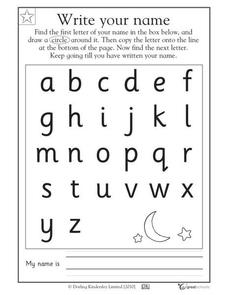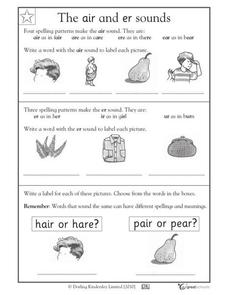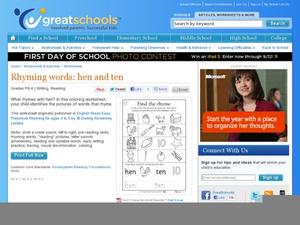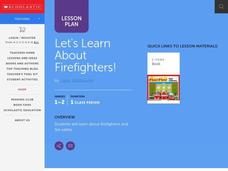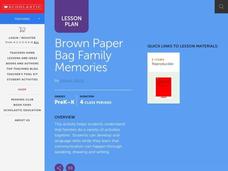Curated OER
Match the Rhymes
Which ones rhyme with swing? There are six images and scholars determine which ones rhyme. Two of the words are written out below to incorporate some printing practice as scholars trace the letters to form each single-syllable word....
Curated OER
v and w
Have fun with lowercase letters v and w as scholars get some printing practice. They use dotted lines and arrows to get some printing practice before writing a set on their own for each letter. Then, they complete an image of...
Curated OER
Creating Letter-shape Patterns #2
Before learners become writers they need to feel comfortable moving a pencil from left to right in various patterns. Use these exercises to give budding printers some fine motor practice. They complete three patterns by tracing a dotted...
Curated OER
Letters U and V
Little learners familiarize themselves with the letters u and v. They find objects in each of two pictures that begin with either v or u. They say the sound of each letter and then trace it several times.
Curated OER
Write Your Name
Kids love to write their own name. Here is a twist on the old trace and write your name three times task. Little ones hunt through the provided alphabet and circle the letters in their name. Then they write the letters on the line...
Curated OER
Vowel Sounds: /air/ and /er/
All the best readers started out the same way. Build the foundational skills needed to recognize vowel sounds like /air/ and /er/. Early readers write a word to label each of nine images. Each image focuses on a different spelling...
Curated OER
Rhyming Words: Hen and Ten
It's rhyme time! Little ones look at the image in each of four rows, they then circle an image that rhymes. They match four rhyming words and trace the words hen and ten.
Curated OER
Reading: Classroom Words
There are 10 classroom words located at the top of this instructional activity. Kindergartners match the word to the object in the picture, they write that word on the line near that object. This is a great way for them to recognize...
Curated OER
Practicing Straight Lines
Pre-writers get ready to print letters with this tracing instructional activity. Youngsters complete two images by tracing lines. They start at each dot, following the arrows from top to bottom. There are 13 straight lines and one circle...
Curated OER
Practicing Circles
Get your writers ready to print curved letters using this whimsical worksheet. They trace 14 circular elements in an underwater scene, following the arrow and trying to stay on the dotted line. There are large and small circles here to...
Curated OER
Phonics Instruction: Writing Simple Words
Sound it out, read it, then sound it out, and write it. Little ones work as a class to sound out simple words. After they have sounded out each word they will write that word on the white board. This is a great way to build a connection...
Florida Center for Reading Research
Phonics: Onset and Rime, Word-Roll-A-Rama
Learners roll two die; die one contains various onsets, and die two contains different rimes. They write down the onset and rime pair they get, then blend and read their word.
Florida Center for Reading Research
Phonics: Encoding and Decoding, Letter Cube Blending
Emergent readers use a letter cube to identify, blend, and make words. They roll each of the three-letter cubes, mark down the letters they rolled, then blend the letter sounds together to make a word. They record each word on a...
Florida Center for Reading Research
Phonics: Onset and Rime, Word Swat
With a fly swatter in hand, learners swat the rime-flys with their onset swatter to make, read, and write words by blending the onset with the rime-fly. Scholars blend words, make and write words, and also work to determine if the words...
Florida Center for Reading Research
Phonics: Varient Correspondances, Silent "e" Changes
Engage early readers in a silent e activity to help them understand the changes the letter can make to a simple word. With the provided cards, learners read and write each word as it appears without the silent e. Then they read and write...
Curated OER
Moving Left to Right
To get scholars ready for the curves, twists, and turns of alphabet letters, give them this tracing exercise. Early writers follow dotted lines with their finger from left to right first, then trace it with a pencil. The images are...
Curated OER
Writing lowercase a and d
Printing practice is essential for aiding children in developing motor control and printing skills. They practice printing by tracing and then write the letters a and d several times each.
Curated OER
Phonics: Decode and Write Words with Blends
Kids see, say, then count the phonemes they hear in a series of simple words. They practice counting phonemes with the teacher, then sound out the same word on their own. As they count each phoneme they write it down on their paper. A...
Curated OER
The Phoenicians
Introduce the ancient culture of the Phoenicians to your class. They'll find out that the Phoenicians were sailors, adopted hieroglyphics from Egypt, traded goods, and had colonies. Comprehension questions are included to build strong...
Curated OER
Let's Learn About Firefighters!
Students explore, analyze and study about fire fighters and fire safety. They listen to a book, list what they already know about firefighters and fire safety rules and compare/contrast types of firefighters. Each student then writes a...
Curated OER
Activity Plan 5-6: Let's Create Stories!
Learners examine wordless books and other pictures in order to learn how the teacher "reads a picture" to tell a story about it. In this early writing lesson, students then create their own picture for story telling by painting....
Curated OER
I'm Special Books
Students become aware of the concept that each of us is special. They develop an appreciation for the special things that each can do now, and begin to develop early literacy skills. Each student creates a book about themselves and...
Curated OER
Brown Paper Bag Family Memories
Students explore and study how families do a variety of activities together. They recall and describe a family memory, collect an object that represents a family memory as well as draw and write about a family memory. They become aware...






